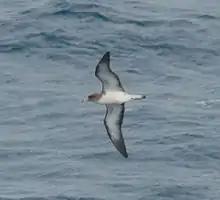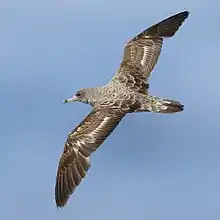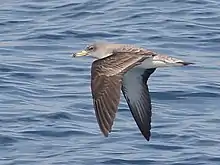Calonectris
Calonectris is a genus of seabirds. The genus name comes from Ancient Greek kalos, "good" and nectris, "swimmer".[1]
| Calonectris | |
|---|---|
 | |
| Scientific classification | |
| Kingdom: | Animalia |
| Phylum: | Chordata |
| Class: | Aves |
| Order: | Procellariiformes |
| Family: | Procellariidae |
| Genus: | Calonectris Mathews & Iredale, 1915 |
| Species | |
|
Calonectris leucomelas | |
The genus comprises four large shearwaters. There are two other shearwater genera. Puffinus, which comprises about twenty small to medium-sized shearwaters, and Procellaria with another four large species. The latter are usually named as petrels, although they are thought to be more closely related to the shearwaters than to the other petrels.
The taxonomy of this group is the cause of some debate, and it is only recently that the Cape Verde shearwater has been split from Cory's shearwater.
The species in this group are long-winged birds, dark brown or grey-brown above, and mainly white below. They are pelagic outside the breeding season. They are most common in temperate and cold waters.
These tubenose birds fly with stiff wings, and use a shearing flight technique to move across wave fronts with the minimum of active flight. Their flight appears more albatross-like than the Puffinus species.
Calonectris shearwaters are long-distance migrants. The streaked shearwater disperses from its east Asian breeding islands throughout the western Pacific and into the eastern Indian Ocean.
Cory's has two subspecies. C. d. diomedea breeds in the Mediterranean and C. d. borealis on the Azores, Canaries and Madeira. It disperses throughout the Atlantic Ocean and into the western Indian Ocean. These may be distinct species (Heidrich et al. 1998).
Calonectris shearwaters come to islands and coastal cliffs only to breed. They are nocturnal at the colonial breeding sites, preferring moonless nights to minimise predation. They nest in burrows and often give eerie contact calls on their night time visits. They lay a single white egg.
They feed on fish, squid and similar oceanic food. They will follow fishing boats to take scraps.
List of species
| Image | Scientific name | Common Name | Length | Wingspan | Distribution |
|---|---|---|---|---|---|
 | Calonectris leucomelas | Streaked shearwater | 48 cm (19 in) | 122 cm (48 in) | Pacific Ocean, nesting in Japan and the Korean Peninsula |
 | Calonectris borealis | Cory's shearwater | 45–56 cm (18–22 in) | 112–126 cm (44–50 in) | Madeira, the Azores and the Berlengas Archipelago in Portugal and the Canary Islands in Spain. |
 | Calonectris diomedea | Scopoli's shearwater | 44–49 cm (17–19 in) | 117–135 cm (46–53 in)[2] | Menorca, Ibiza, Formentera, Cabrera, Conillera and Dragonera in the Balearics; on the Îles d'Hyères in France; on Elba, small islands off Sardinia and Sicily, Pantelleria and Lampedusa in Italy; In Malta; on coastal Croatian islands and parts of the mainland; on Kythira, Kolpos and the Cyclades in Greece |
| Calonectris edwardsii | Cape Verde shearwater | 42–47 cm (17–19 in) | 101–112 cm (40–44 in)[3] | Cape Verde Islands | |
Extinct species, Calonectris krantzi from the Early Pliocene and Calonectris wingatei from the Middle Pleistocene, have also been described from fossils. Calonectris kurodai, another fossil from the Middle Miocene Calvert Formation of Chesapeake Bay is named after the Japanese ornithologist Nagahisa Kuroda.[4]
References
- Jobling, James A (2010). The Helm Dictionary of Scientific Bird Names. London: Christopher Helm. pp. 86, 267. ISBN 978-1-4081-2501-4.
- "Scopoli's Shearwater (Calonectris diomedea)". HBW Alive. 2020-01-21. Retrieved 2020-01-21.
- "Cape Verde Shearwater (Calonectris edwardsii)". HBW Alive. 2020-01-21. Retrieved 2020-01-21.
- Olson, Storrs L. (2009). "A new diminutive species of shearwater of the genus Calonectris (Aves: Procellariidae) from the Middle Miocene Calvert Formation of Chesapeake Bay". Proceedings of the Biological Society of Washington. 122 (4): 466. doi:10.2988/09-19.1.
- Harrison, Peter (1987): Seabirds of the World: A Photographic Guide. Princeton University Press, Princeton. ISBN 0-691-01551-1
- Heidrich, Petra; Amengual, José F. & Wink, Michael (1998): Phylogenetic relationships in Mediterranean and North Atlantic shearwaters (Aves: Procellariidae) based on nucleotide sequences of mtDNA. Biochemical Systematics and Ecology 26(2): 145–170. doi:10.1016/S0305-1978(97)00085-9 PDF fulltext